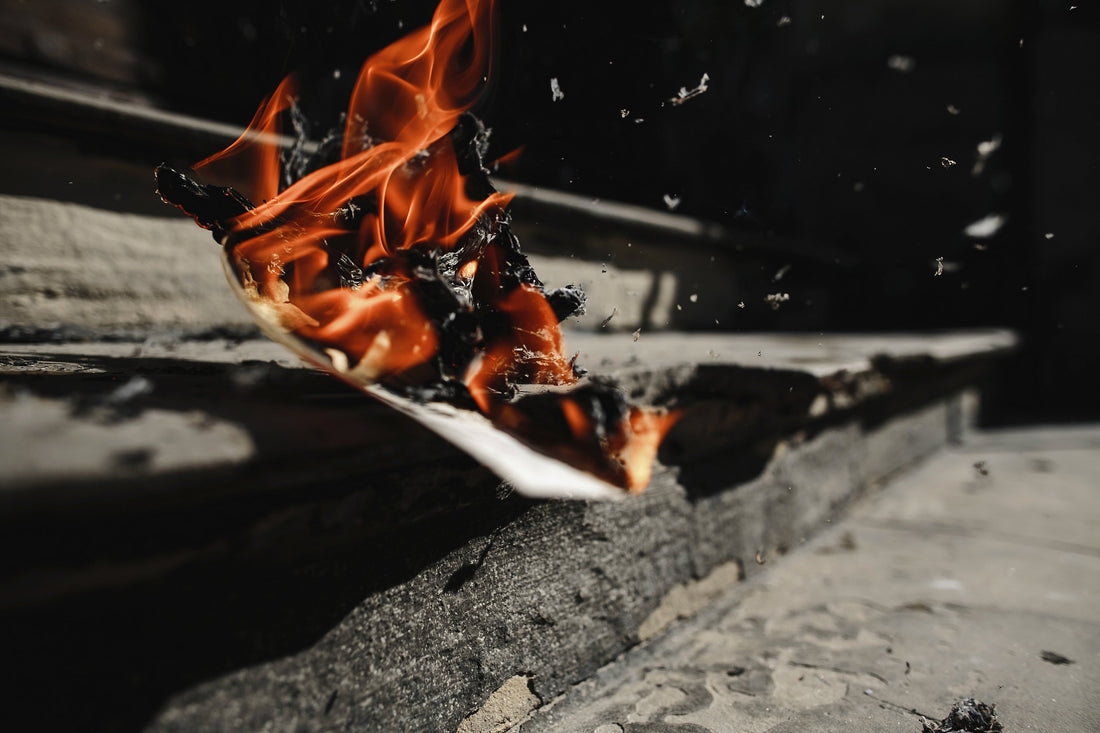When winter arrives and the cold sets in, there’s nothing more comforting than the crackle of a fire in the wood stove. The warmth it provides, along with the cosy atmosphere, is hard to beat. But as with all good things, a few precautions must be taken when it comes to using your wood stove. One common question we often hear is: "Can I burn paper in a wood stove?" you may have a pile of old newspapers or unwanted mail lying around. While it might seem like a convenient solution, burning paper in your wood stove can have unintended consequences.
In this blog post, we'll explore why burning paper in a wood stove is not a good idea and what you can do instead to safely dispose of paper waste.
The Risks of Burning Paper in a Wood Stove
1. Fire Hazard:
The most significant risk associated with burning paper in a wood stove is the potential for an out-of-control fire. Paper burns very quickly and can create intense, erratic flames. This can cause the stove to overheat, potentially damaging the appliance or even starting a fire in your home. Paper, especially glossy or coloured paper (such as magazines or catalogues), often contains chemicals or inks that, when burned, can create toxic fumes. Inhaling these fumes can be harmful to your health and, in extreme cases, cause respiratory issues.
2. Creosote Buildup:
Another danger of burning paper is the build-up of creosote in your chimney. Creosote is a highly flammable substance that accumulates in chimneys when wood or paper is burned at low temperatures. Paper burns hotter and faster than wood, but not necessarily in the way you want it to. This rapid combustion often leads to incomplete combustion, meaning the smoke and gases aren’t fully burned off. These gases then condense inside the chimney, leading to the formation of creosote. Over time, this thick tarry substance can coat the inside of your chimney, increasing the risk of a dangerous chimney fire.
3. Damage to the Stove:
Wood stoves are designed to burn wood efficiently and safely. When paper is burned, the stove's combustion system is often pushed beyond its intended limits. The high flames and unpredictable burning behaviour can damage key components of the stove, such as the firebox or chimney pipes. Paper doesn’t burn with the steady, predictable heat that wood provides, so subjecting your stove to this type of burning can lead to wear and tear.
4. Air Pollution:
Burning paper also contributes to air pollution. When paper is burned, it releases carbon dioxide (CO2) and potentially harmful particulate matter into the air. The emission of these particles can have a negative impact on both indoor and outdoor air quality. If you have a wood stove in a well-sealed home, these emissions can linger indoors and degrade the air quality, causing discomfort or health problems for residents, especially those with respiratory conditions such as asthma.
What Can You Do Instead?
If you're looking for a safe and environmentally friendly way to dispose of unwanted paper, there are several better options than burning it in your wood stove.
1. Recycling:
The best way to dispose of paper waste is to recycle it. Most paper products, including newspapers, cardboard, and office paper, are recyclable. By recycling, you’re contributing to the reduction of waste and helping preserve natural resources. In addition, recycling helps to reduce the need for raw materials and saves energy. Many local councils provide curbside recycling services, so it's easy to collect your paper waste and have it properly recycled.
2. Composting:
Another great option for paper disposal is composting. Paper that is uncoated and free from inks, such as plain newspaper or cardboard, can be added to your compost bin. As it decomposes, it adds valuable organic matter to your compost, which can then be used to enrich your garden soil. Just make sure to avoid glossy or heavily inked paper, as these materials may not break down properly and could contain harmful chemicals.
3. Shredding for Packaging or Craft Projects:
If you have paper that can’t be recycled or composted, consider using it in other creative ways. Shredded paper makes great packing material for fragile items when you're moving or shipping. You can also use shredded paper in craft projects or as mulch in your garden. This helps reduce waste while also serving a useful purpose.
When is It Safe to Burn Paper?
There are a few exceptions when burning paper might be acceptable. If you are using a wood stove or a fireplace that is specifically designed to handle fast-burning materials like paper, and you’re taking steps to ensure proper ventilation and safety, then it may be permissible in limited amounts. However, this is not the case for most standard wood stoves. If you’re unsure, it’s always best to consult the manufacturer’s guidelines for your stove to determine what is safe to burn.
Conclusion
While it may seem tempting to toss old newspapers or junk mail into the fire for convenience, burning paper in a wood stove is not advisable. It can create significant risks, including fire hazards, creosote buildup and damage to your stove. Instead, consider safer alternatives like recycling, composting, or repurposing the paper for other uses.
If you want to keep your wood stove in top condition and make sure your firewood burns efficiently, it’s important to use only seasoned wood. If you’re looking to stock up on high-quality firewood, we’re here to help. At [Your Company Name], we offer premium firewood that’s seasoned, dry, and ready to burn. By choosing our firewood, you can enjoy a safe, warm fire without worrying about the dangers of burning paper or other inappropriate materials.
Contact us today to order your firewood and get ready for a cosy and safe winter season!
